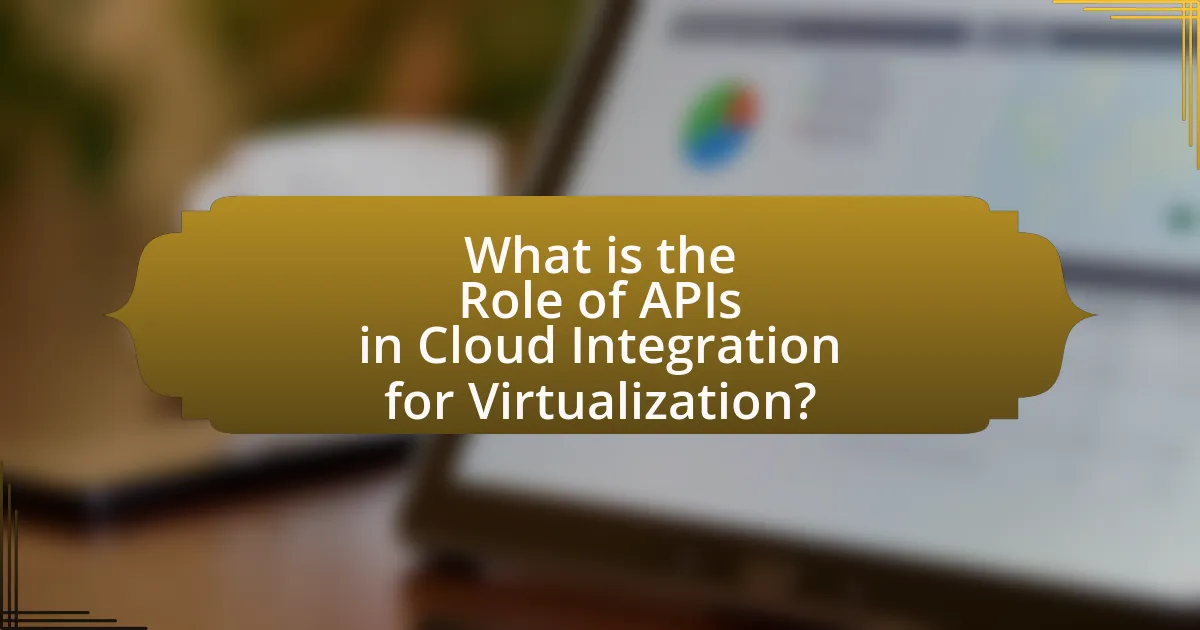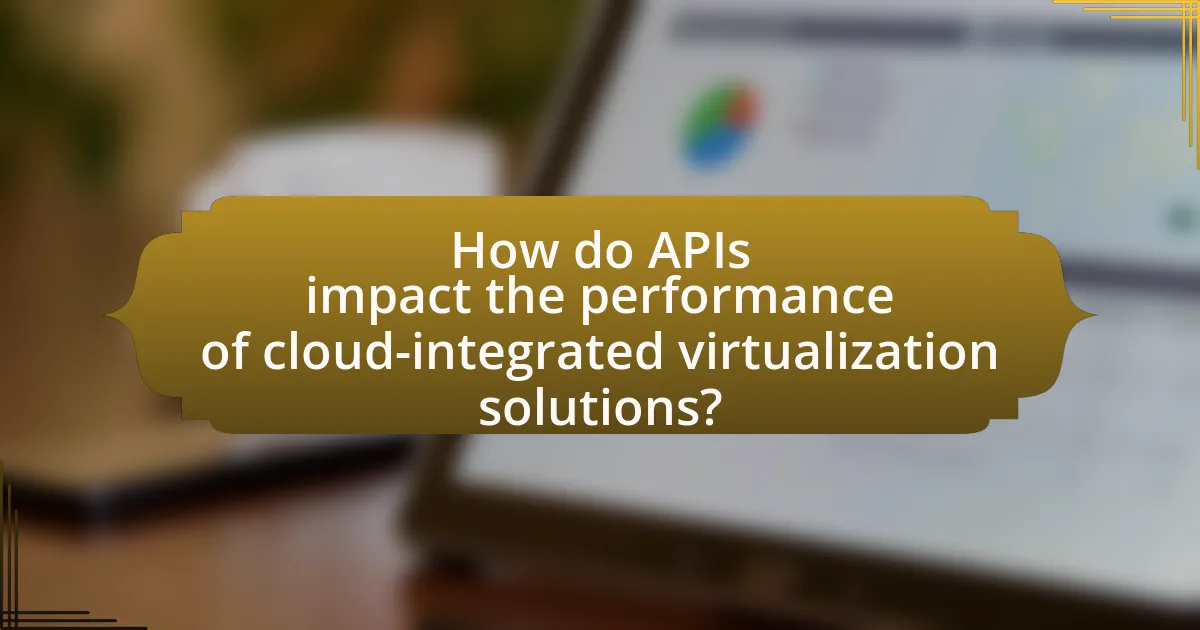APIs are essential components in cloud integration for virtualization, facilitating seamless communication between software applications and cloud services. They enable efficient data exchange, resource management, and automation, which are critical for optimizing operational efficiency and scalability in virtualized environments. The article explores the various roles of APIs, including their functions, types, and the advantages they offer, such as improved interoperability and security. Additionally, it addresses challenges in cloud integration, performance metrics, and best practices for effective API management, highlighting the significant impact of APIs on modern virtualization strategies.
What is the Role of APIs in Cloud Integration for Virtualization?

APIs play a crucial role in cloud integration for virtualization by enabling seamless communication between different software applications and cloud services. They facilitate the exchange of data and commands, allowing virtualized resources to be managed and orchestrated efficiently across various platforms. For instance, APIs allow cloud service providers to expose their functionalities, such as provisioning and scaling virtual machines, to developers and third-party applications, thereby enhancing interoperability and automation. This integration is essential for businesses to leverage cloud capabilities effectively, as it supports dynamic resource allocation and improves overall operational efficiency.
How do APIs facilitate cloud integration in virtualization environments?
APIs facilitate cloud integration in virtualization environments by enabling seamless communication between different software applications and cloud services. They provide standardized protocols and tools that allow virtualized resources to interact with cloud platforms, ensuring efficient data exchange and management. For instance, APIs allow virtualization management tools to provision, monitor, and control virtual machines hosted in the cloud, thereby enhancing operational efficiency and scalability. This integration is supported by industry standards such as REST and SOAP, which ensure compatibility across various systems and services, thus validating the effectiveness of APIs in streamlining cloud operations within virtualization contexts.
What are the key functions of APIs in this context?
APIs serve as critical intermediaries in cloud integration for virtualization by enabling seamless communication between different software applications and services. They facilitate data exchange, allowing virtualized resources to interact with cloud services efficiently. APIs also provide standardized protocols for accessing and managing cloud resources, ensuring interoperability among diverse systems. Furthermore, they enhance automation by allowing developers to programmatically control virtual environments, leading to improved scalability and resource management. The effectiveness of APIs in this context is evidenced by their widespread adoption in cloud platforms, which rely on APIs to integrate various services and streamline operations.
How do APIs enhance communication between cloud services and virtualization platforms?
APIs enhance communication between cloud services and virtualization platforms by providing standardized interfaces that facilitate data exchange and interoperability. These interfaces allow different systems to communicate seamlessly, enabling cloud services to manage virtual resources effectively. For instance, APIs enable the automation of resource provisioning, scaling, and management tasks, which improves operational efficiency. Additionally, APIs support the integration of various services, allowing for a cohesive environment where cloud applications can interact with virtualized infrastructure. This capability is evidenced by the widespread use of RESTful APIs in cloud platforms, which adhere to common protocols and data formats, ensuring compatibility and ease of use across diverse systems.
Why are APIs essential for effective cloud integration in virtualization?
APIs are essential for effective cloud integration in virtualization because they facilitate seamless communication between different software applications and cloud services. By providing standardized protocols and tools, APIs enable developers to connect virtualized resources with cloud platforms efficiently. This integration allows for automated resource management, scalability, and interoperability among diverse systems, which is crucial for optimizing cloud operations. For instance, according to a report by Gartner, organizations that effectively utilize APIs in their cloud strategies can achieve up to 30% faster deployment times and improved resource utilization, demonstrating the significant impact of APIs on cloud integration in virtualization.
What challenges do APIs address in cloud integration?
APIs address several challenges in cloud integration, including interoperability, data consistency, and security. Interoperability issues arise when different cloud services and applications need to communicate; APIs provide standardized protocols that facilitate this communication. Data consistency challenges occur when multiple systems handle the same data; APIs enable real-time data synchronization across platforms, ensuring that all systems reflect the most current information. Security concerns are prevalent in cloud environments; APIs can implement authentication and authorization protocols to safeguard data access and maintain compliance with regulations.
How do APIs improve scalability and flexibility in virtualization?
APIs enhance scalability and flexibility in virtualization by enabling seamless integration and management of resources across diverse environments. They allow for dynamic provisioning and de-provisioning of virtual machines, which facilitates the rapid scaling of resources based on demand. For instance, cloud service providers utilize APIs to automate the deployment of virtual instances, ensuring that resources can be adjusted in real-time without manual intervention. This capability is supported by industry standards such as REST and SOAP, which provide a consistent framework for communication between services. Consequently, organizations can respond quickly to changing workloads, optimize resource utilization, and reduce operational costs, demonstrating the critical role of APIs in modern virtualization strategies.
What types of APIs are commonly used in cloud integration for virtualization?

Commonly used APIs in cloud integration for virtualization include REST APIs, SOAP APIs, and GraphQL APIs. REST APIs are widely adopted due to their simplicity and stateless nature, allowing for easy integration with cloud services. SOAP APIs provide a protocol for exchanging structured information, which is beneficial for enterprise-level applications requiring high security and reliability. GraphQL APIs offer a flexible query language that enables clients to request only the data they need, optimizing data retrieval in cloud environments. These API types facilitate seamless communication between virtualized resources and cloud platforms, enhancing operational efficiency and scalability.
What are RESTful APIs and how do they apply to cloud integration?
RESTful APIs are application programming interfaces that adhere to the principles of Representational State Transfer, enabling communication between client and server over HTTP. They apply to cloud integration by allowing different cloud services and applications to interact seamlessly, facilitating data exchange and functionality across diverse platforms. RESTful APIs utilize standard HTTP methods such as GET, POST, PUT, and DELETE, which simplifies the integration process and enhances interoperability among cloud-based systems. This approach is widely adopted due to its stateless nature, scalability, and ease of use, making it a foundational element in modern cloud architectures.
What advantages do RESTful APIs offer in virtualization scenarios?
RESTful APIs provide several advantages in virtualization scenarios, including simplicity, scalability, and interoperability. Their stateless nature allows for easy integration with various cloud services, enabling efficient resource management and dynamic scaling. Additionally, RESTful APIs utilize standard HTTP methods, which facilitate communication between different systems and platforms, enhancing compatibility across diverse environments. This compatibility is crucial in virtualization, where multiple virtual machines and services need to interact seamlessly. Furthermore, the lightweight nature of RESTful APIs reduces overhead, improving performance in resource-constrained environments typical of virtualization.
How do RESTful APIs compare to other API types in this context?
RESTful APIs are generally more efficient and easier to use compared to other API types, such as SOAP or GraphQL, in the context of cloud integration for virtualization. RESTful APIs utilize standard HTTP methods, making them lightweight and suitable for web-based applications, which is essential for cloud environments. In contrast, SOAP APIs are more complex due to their reliance on XML and strict protocols, which can hinder performance and increase overhead. GraphQL, while flexible in querying, can lead to over-fetching or under-fetching of data, complicating integration efforts. The simplicity and stateless nature of RESTful APIs facilitate faster development and scalability, aligning well with the dynamic requirements of cloud virtualization.
What role do SOAP APIs play in cloud integration for virtualization?
SOAP APIs facilitate cloud integration for virtualization by providing a standardized protocol for exchanging structured information between applications over the internet. This standardization allows different systems, regardless of their underlying technology, to communicate effectively, enabling seamless integration of virtualized resources across diverse cloud environments. For instance, SOAP APIs support operations such as provisioning, management, and orchestration of virtual machines, which are essential for optimizing resource utilization and enhancing scalability in cloud infrastructures. The use of XML for message formatting in SOAP APIs ensures that data is both machine-readable and human-readable, further promoting interoperability among various cloud services.
What are the strengths and weaknesses of using SOAP APIs?
SOAP APIs offer several strengths and weaknesses. The strengths include strong security features, as SOAP supports WS-Security for message integrity and confidentiality, making it suitable for enterprise-level applications. Additionally, SOAP APIs are highly standardized, providing a consistent protocol for communication, which facilitates interoperability across different platforms and languages. Their ability to handle complex transactions and support for ACID-compliant transactions further enhances their reliability in critical applications.
Conversely, the weaknesses of SOAP APIs include their complexity and verbosity, which can lead to increased bandwidth consumption and slower performance compared to RESTful APIs. The requirement for extensive XML parsing can also complicate implementation and increase development time. Furthermore, SOAP APIs are less flexible than REST APIs, as they are tightly coupled with the underlying protocol, making them less adaptable to changes in technology or business requirements.
In what situations are SOAP APIs preferred over RESTful APIs?
SOAP APIs are preferred over RESTful APIs in situations requiring high security, formal contracts, and complex transactions. For instance, SOAP is often utilized in enterprise-level applications where WS-Security is essential for message integrity and confidentiality. Additionally, SOAP’s strict standards and protocols, such as WSDL (Web Services Description Language), provide a clear contract between the service provider and consumer, making it suitable for scenarios where precise operations and data types are critical. Furthermore, SOAP supports ACID-compliant transactions, which are necessary in financial services and other industries where data consistency and reliability are paramount.
How do APIs impact the performance of cloud-integrated virtualization solutions?

APIs significantly enhance the performance of cloud-integrated virtualization solutions by facilitating seamless communication between different software components and services. This integration allows for efficient resource management, enabling virtualization platforms to dynamically allocate resources based on demand, which optimizes performance and reduces latency. For instance, APIs enable automated scaling of virtual machines in response to real-time usage metrics, ensuring that resources are utilized effectively. Furthermore, studies have shown that organizations leveraging APIs in their virtualization strategies can achieve up to 30% faster deployment times and improved operational efficiency, as they streamline workflows and reduce manual intervention.
What metrics can be used to measure API performance in this context?
Key metrics to measure API performance in the context of cloud integration for virtualization include response time, throughput, error rate, and latency. Response time quantifies how quickly an API responds to requests, which is critical for user experience and system efficiency. Throughput measures the number of requests processed in a given time frame, indicating the API’s capacity to handle load. Error rate tracks the percentage of failed requests, providing insight into reliability and stability. Latency assesses the delay before a transfer of data begins following a request, impacting overall performance. These metrics collectively help in evaluating the effectiveness and efficiency of APIs in cloud environments.
How does API latency affect overall system performance?
API latency negatively impacts overall system performance by increasing response times and reducing throughput. When APIs experience high latency, the time taken for requests to be processed and responses to be received extends, leading to slower application performance. This delay can cause bottlenecks in data flow, particularly in cloud integration scenarios where multiple services interact. For instance, a study by Amazon Web Services found that a 100-millisecond increase in latency can lead to a 1% decrease in sales for e-commerce platforms, illustrating the direct correlation between API latency and user experience. Thus, minimizing API latency is crucial for maintaining optimal system performance and ensuring efficient cloud integration.
What strategies can be employed to optimize API performance?
To optimize API performance, strategies such as implementing caching, reducing payload size, and using asynchronous processing can be employed. Caching frequently requested data minimizes server load and decreases response times, as evidenced by studies showing that caching can improve performance by up to 90%. Reducing payload size through techniques like data compression and minimizing unnecessary fields enhances transmission speed, with research indicating that smaller payloads can lead to faster processing times. Asynchronous processing allows for non-blocking operations, improving throughput and user experience, as demonstrated by systems that handle multiple requests simultaneously without waiting for each to complete.
What security considerations should be taken into account when using APIs for cloud integration?
When using APIs for cloud integration, key security considerations include authentication, authorization, data encryption, and monitoring. Authentication ensures that only legitimate users can access the API, while authorization controls what those users can do within the API. Data encryption protects sensitive information during transmission and storage, mitigating the risk of data breaches. Monitoring API usage helps detect and respond to suspicious activities in real-time, enhancing overall security. According to the 2021 API Security Report by Salt Security, 94% of organizations experienced an API security incident in the past year, highlighting the critical need for robust security measures in API management.
How can API security vulnerabilities impact virtualization environments?
API security vulnerabilities can significantly compromise virtualization environments by allowing unauthorized access to virtual machines and sensitive data. When APIs are exploited, attackers can manipulate or control virtual resources, leading to data breaches, service disruptions, and unauthorized changes to configurations. For instance, a study by the Cloud Security Alliance found that 94% of organizations experienced API-related security incidents, highlighting the critical need for robust API security measures in virtualization contexts. These vulnerabilities can also facilitate lateral movement within the network, enabling attackers to escalate privileges and access additional resources, further jeopardizing the integrity and confidentiality of the entire virtualization environment.
What best practices should be followed to secure APIs in cloud integration?
To secure APIs in cloud integration, organizations should implement authentication and authorization mechanisms, such as OAuth 2.0, to ensure that only legitimate users can access the APIs. Additionally, employing HTTPS for all API communications protects data in transit from eavesdropping and man-in-the-middle attacks. Rate limiting should be enforced to prevent abuse and denial-of-service attacks, while input validation helps mitigate injection attacks. Regular security audits and vulnerability assessments are essential to identify and address potential weaknesses in the API infrastructure. According to the 2021 API Security Report by Salt Security, 95% of organizations experienced an API security incident in the past year, highlighting the critical need for these best practices.
What are the common pitfalls to avoid when implementing APIs for cloud integration in virtualization?
Common pitfalls to avoid when implementing APIs for cloud integration in virtualization include inadequate documentation, lack of version control, and insufficient security measures. Inadequate documentation can lead to misunderstandings and misuse of the API, making it difficult for developers to integrate effectively. Lack of version control can result in compatibility issues, as changes to the API may break existing integrations. Insufficient security measures can expose sensitive data and create vulnerabilities, as APIs often serve as gateways to cloud services. These pitfalls can significantly hinder the effectiveness of cloud integration efforts and compromise the overall security and functionality of the virtualized environment.
How can poor API design affect cloud integration outcomes?
Poor API design can significantly hinder cloud integration outcomes by creating inefficiencies and increasing the complexity of data exchange between systems. When APIs are poorly structured, they may lead to inconsistent data formats, which complicates the integration process and can result in data loss or corruption. For instance, a study by MuleSoft found that 83% of IT leaders reported that poor API design led to integration challenges, ultimately affecting application performance and user experience. Additionally, inadequate documentation and lack of standardization in API design can cause developers to spend more time troubleshooting and less time on innovation, further delaying project timelines and increasing costs.
What are the consequences of inadequate API documentation?
Inadequate API documentation leads to increased development time and higher error rates. Developers struggle to understand how to implement APIs effectively, resulting in misconfigurations and bugs. A study by the Harvard Business Review found that poor documentation can increase project costs by up to 30% due to the time spent troubleshooting and seeking clarification. Additionally, inadequate documentation can hinder collaboration among teams, as unclear guidelines create barriers to effective communication and integration. This ultimately impacts the overall efficiency and success of cloud integration projects in virtualization.
What best practices can enhance the effectiveness of APIs in cloud integration for virtualization?
Best practices that enhance the effectiveness of APIs in cloud integration for virtualization include ensuring robust security measures, implementing version control, and optimizing performance through efficient data handling. Robust security measures, such as OAuth and API gateways, protect sensitive data and prevent unauthorized access, which is critical given the increasing number of cyber threats. Implementing version control allows for seamless updates and backward compatibility, ensuring that existing integrations remain functional while new features are introduced. Optimizing performance through efficient data handling, such as using pagination and caching strategies, reduces latency and improves user experience. These practices collectively contribute to a more reliable and efficient API ecosystem in cloud integration for virtualization.
How can organizations ensure seamless API integration with existing systems?
Organizations can ensure seamless API integration with existing systems by adopting standardized protocols and thorough documentation. Standardized protocols, such as REST or SOAP, facilitate consistent communication between systems, reducing compatibility issues. Comprehensive documentation provides clear guidelines on how to implement and utilize APIs effectively, which minimizes errors during integration. Additionally, organizations should conduct rigorous testing in a controlled environment to identify potential integration challenges before deployment. This approach is supported by industry practices that emphasize the importance of interoperability and testing in successful API integration projects.
What tools and frameworks can assist in API management for virtualization?
Tools and frameworks that assist in API management for virtualization include Apigee, MuleSoft, and AWS API Gateway. Apigee provides comprehensive API management capabilities, including analytics, security, and traffic management, which are essential for virtualized environments. MuleSoft offers a unified integration platform that enables organizations to connect applications, data, and devices through APIs, facilitating seamless virtualization. AWS API Gateway allows developers to create, publish, maintain, and secure APIs at any scale, making it a vital tool for managing APIs in cloud-based virtualization scenarios. These tools enhance the efficiency and effectiveness of API management in virtualized infrastructures.




